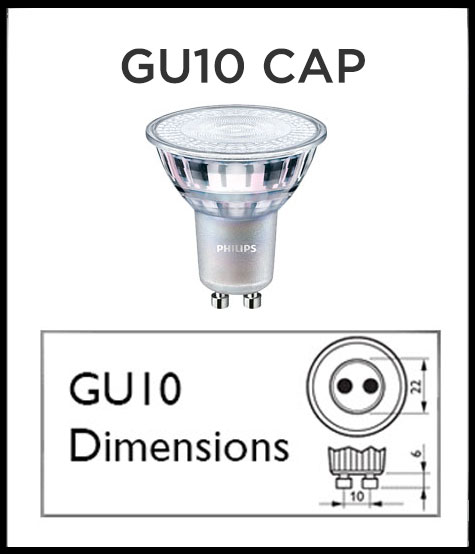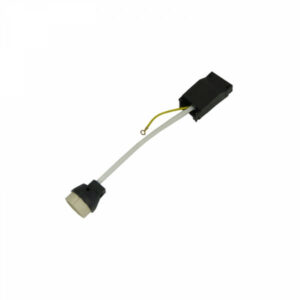GU10 Bulbs & MR16 Lights - What's the Difference?
When considering new lighting solutions for your home, it's crucial to understand the differences between popular light bulb types. GU10 and MR16 bulbs are both popular choices, but each has its own set of advantages and disadvantages. This in-depth guide aims to help UK consumers make informed buying decisions by providing comprehensive information on GU10 and MR16 lights. We'll cover what these lights are, their unique features, advantages, disadvantages, and other essential factors to consider when choosing between them.



What are GU10 and MR16 Lights?
GU10 and MR16 lights are types of halogen or LED lamps or light bulbs typically used in recessed downlights and spotlights. They’re commonly used for accent and task lighting in homes and commercial spaces. They both basically do the same thing except that one operates on mains voltage and the other one operates on low voltage. They have a similar appearance, with a reflective surface and a lens to focus the light. However, there are some key differences between them:- Base type. GU10 bulbs have a twist-and-lock base with two thick pins, while MR16 bulbs have a push-fit base with two thin, sharper pins.
- GU10 bulbs are designed for 220-240V mains voltage, common in the UK, whereas MR16 bulbs typically use 12V and require a transformer to reduce the mains voltage.


Advantages of GU10 Lights
- Easy installation. GU10 bulbs have a twist-and-lock mechanism, making them easy to install and replace. There's no need for additional transformers, as they work with the UK's standard 220-240V mains voltage.
- Energy efficiency. LED GU10 bulbs are energy-efficient, consuming less power than traditional halogen bulbs and offering a longer lifespan.
- GU10 bulbs are available in dimmable versions, allowing you to control the brightness and create the desired atmosphere.
- GU10 bulbs come in various colour temperatures and beam angles, making them suitable for various applications, from accent to task lighting.
Disadvantages of GU10 Lights
- Heat output. Before they were banned halogen GU10 bulbs did produce slightly more heat than MR16, but low energy LED versions operate at similar temperatures to each other.
- Brightness. MR16 halogens did used to be around 30% brighter, LED GU10s are almost as bright, the Philips 6.2W GU10 for example has a light output of up to 575 lumens which is classed as an 80W equivalent.
Advantages of MR16 Lights
- MR16 bulbs work with 12V, which means they are safer to use in damp places like bathrooms, but if you're using them in IP65 rated downlights then the GU10 option is also suitable.
- Precise lighting. MR16 bulbs are available in a wider choice of beam angles including very narrow versions like 15 degrees which can be used to create a more focused effect or accent lighting.
- Retrofit solution. Can be used to replace existing low voltage halogen MR16s, but sometimes the LED doesn’t work with the existing transformer.
Disadvantages of MR16 Lights
- Transformer requirement. MR16 bulbs need a transformer to convert the UK's standard 220-240V mains voltage to 12V. This can add extra costs and complexity to the installation process.
- Compatibility issues. Not all MR16 bulbs are compatible with all transformers, and some LED versions may require a specific type of transformer for optimal performance.
- If you’re dimming them, the MR16, transformer and dimmer switch must all be compatible. Otherwise you can experience flicker or strobing effects.
Making an Informed Decision
When choosing between GU10 and MR16 lights, consider the following factors:- GU10 bulbs are easier to install, while MR16 bulbs require a transformer.
- Energy efficiency. Both LED GU10 and MR16 bulbs offer energy savings, but the former works directly with UK mains voltage.
- Lighting purpose. Consider the intended use, such as accent lighting, task lighting, or general illumination, and choose the bulb type that best suits your needs.
- Dimming capabilities. If you want to control the brightness, ensure you choose dimmable GU10 or MR16 bulbs and LED compatible dimmer switches such as Varilight V-Pro or Lightwave.
- Colour rendering. Known as CRI (Colour Rendering Index), the standard CRI rating is CRI80 and the highest is 100. Both GU10 and MR16 bulbs are available with higher CRI, the Philips Expert Colour GU10 has a CRI rating of 97 which is almost perfect. Higher colour rendering capabilities may be important for specific applications like displaying artwork or in shops like butchers to display fresh produce.
- Safety. If you need lighting for wet or humid environments, MR16's low voltage operation can be advantageous but most people use GU10 or integrated LED downlights in bathrooms.
- Budget. Consider both the upfront costs and long-term energy savings when making your decision. LED GU10 bulbs may be more expensive initially, but their energy savings and compatibility with UK mains voltage could offset these costs over time.
- Colour temperature. The most popular colour temperature options are 2700K known as extra warm white, this offers a more homely glow that is orange in appearance, halogen and incandescent lamps were mainly this colour temperature. Warm white 3000K is clearer but not too clinical and cool white 4000K which is clearer and whiter in appearance. Choosing the right colour temperature is a matter of choice, a living room would be better suited to a warmer colour tone and a white room such as a bathroom would be better suited to cool white, but a bathroom that you have relaxing bathrooms in would be better with warm white, so you have to make a judgement call.
- Before the days of LED lighting, consumers used to order light bulbs based on their wattage, but brightness is measured in lumens, an old 50W halogen was 350 to 400 lumens, so if you’re upgrading to LED, check what the lumen rating is as you’ll want something that offers the equivalent brightness.
Choosing the Right Bulb for Each Room
Each room in your home serves a unique purpose, and the lighting should complement the activities and ambiance of the space. Let's explore which bulbs, GU10 or MR16, may be more suitable for various rooms in your home.Living Room
The living room is a versatile space where you relax, entertain guests, and enjoy various activities. Layered lighting is essential for creating a comfortable atmosphere. GU10 bulbs are an excellent choice for general illumination. For accent lighting, such as highlighting artwork or bookshelves, high CRI LED bulbs can offer superior colour rendering and you may want to consider more focused beam angles such as 25 degrees. General ceiling lighting in living rooms in downlights would be better suited to wider beam angles of 60 degrees. This is because the living room doesn’t need to be as bright as other rooms like the kitchen, using wider beam angles means you can space the downlights further apart and install fewer of them. You’ll also need brighter LED lamps and the light will spread out further.Kitchen
The kitchen is a functional space where task lighting is crucial. GU10 bulbs are well-suited for general illumination and task lighting. Available in a wide selection of brightnesses, beam angles and colour temperatures.Bedroom
In the bedroom, creating a calming and relaxing atmosphere is essential. GU10 bulbs can provide sufficient general lighting and are compatible with dimmer switches, allowing you to adjust the brightness to your preferences. For bedside reading lights or focused task lighting, integrated LED fittings are a popular choice as they can offer precise beam control without disturbing your partner. A combination of both GU10 for the ceiling and integrated LED for the bedside can enhance the ambiance and functionality of your bedroom.Bathroom
Safety and functionality are vital considerations for bathroom lighting. As MR16 bulbs operate at a lower voltage, they may be a safer choice for wet and humid environments. However, it's essential to ensure that any MR16 fixtures and transformers are adequately protected from moisture. GU10 bulbs can also be suitable for general illumination and can be housed in IP-rated fittings such as recessed downlights, spot lights or wall lights. Always consult a professional electrician when installing lighting in your bathroom to ensure compliance with the Building Regulations.Home Office
In a home office, task lighting is crucial for creating a productive and comfortable work environment. GU10 LED bulbs can provide excellent general illumination, and their energy efficiency is an added bonus for a space where lights may be on for extended periods. For focused task lighting, such as desk lamps or accent lighting on shelving, you may want to consider a more precise beam angle and a high colour rendering LED.Can I use GU10 instead of MR16?
If you've already got MR16 bulbs they will be either be getting powered from a low voltage transformer or directly from a 12V supply. If they're getting powered from a low voltage transformer then you need to convert them into mains voltage GU10 using a converter kit shown below, which will involve disconnecting the transformer from the mains as its no longer required:

